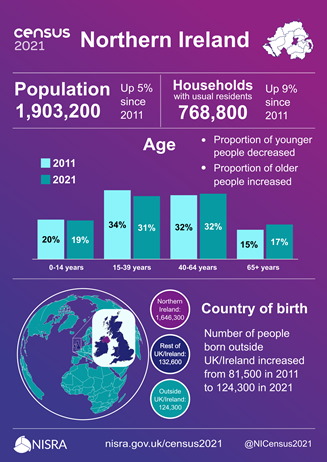The Northern Ireland Statistical and Research Agency has today released its second* set of results from the Northern Ireland Census of 2021. It includes statistics relating to ethnicity; country of birth; passports held; religion; religion or religion brought up in; national identity; and language of its population.
Here are some of the main findings:
Passports: More than 67% and 63% of residents living in the Ards & North Down and Mid & East Antrim districts respectively hold only a UK passport. The lowest proportion of residents holding a UK passport and no other was found in the Derry and Strabane area (29%), where some 48% of residents held only an Irish passport, and only 3.47% held both passports.
Ethnicity: Among Northern Ireland's residents, nearly 32% identified as 'British only' (down from 40% in 2011), just over 29% considered themselves to be Irish only (25% ten years ago), while nearly 20% described themselves as Northern Irish only (previously 21%). Nearly 8% identified as British and Northern Irish only. Some 3.4% (65,600 people), said they belong to ethnic minority groups.
Language –
Irish: Some 12.45% of people over the age of three have some ability in speaking, writing, reading or understanding of Irish. The highest percentage regionally was found in Mid-Ulster (20%), closely followed by the Newry, Mourne & Down area ((18%) and Fermanagh & Omagh (17%). In contrast, nearly 96% of those living in the Ards & North Down district declared themselves to have no ability in Irish. Mid & East Antrim and Lisburn & Castlereagh districts were very close behind.
Ulster Scots: More than 10% (190,613) of people aged three and over have some level of ability in Ulster Scots. Of this total, more than 20% live in Mid & East Antrim and 19% in Causeway Coast & Glens.
Household size: Northern Ireland's population lives in 768,804 households, making an average household size of 2.44 residents. This is the lowest ever recorded. In 1841, the average was 5.18 persons and was still more than 4 in 1851. In 2021, more than 60% of households consist of just one or two persons. The areas with the largest percentage of households consisting of 6 or more persons are in Mid-Ulster (5.3%), Newry, Mourne & Down (4.1%), Fermanagh & Omagh (383%) and Armagh City, Banbridge and Craigavon(3.3%).
Religion: The census of 2021 shows the population of Northern Ireland is becoming less religious. Some 17.39% (330,983 individuals) reported themselves to have no religion. Those claiming to belong to a particular denomination were: (Roman) Catholics making up 42.31% of the population; Presbyterian Church in Ireland 16.61%; (Anglican) Church of Ireland, 11.55%; Methodist 2.35%; Other Christian related groups, 6.85%; Other beliefs, 1.34%. Just 1.6% did not answer this question.
The other standout finding is truly historic: the proportion of the resident population from a Catholic background (45.7%) now outnumbers those from a Protestant background (43.8%); this is the first time this has happened since Northern Ireland was created 101 years ago. The numbers of people from a Protestant background has falled by more than 10% over the last two decades, while the numbers of Catholics has risen by about 3% over the same period. The Guardian has a good analysis of this issue here.
* The first release (published in May) and available to view here, showed the total population to have grown by 5% since 2011 and dealt with ages, household size and type of residence.


